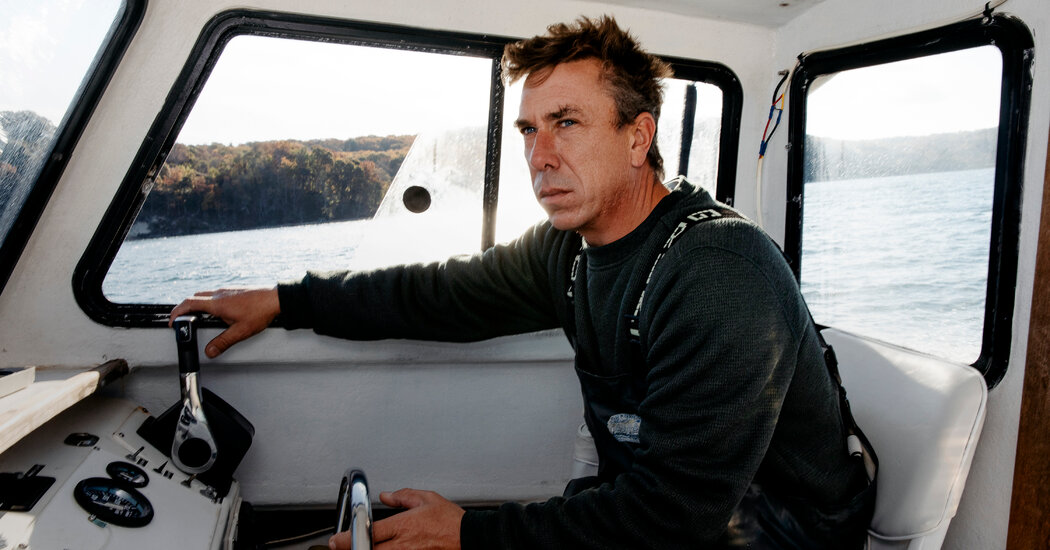“I didn’t come out here with big plans to get rich today,” he said. “You can’t say it’s depressing, because you already know. But you hope.”
He bashed north against the waves, toward the protected bay off Orient, at the far northeast corner of Long Island. He dropped four rusty dredges into the water, just as the bay turned pink with sunrise. He let the outboard rumble the boat around for five minutes. Then he pulled the dredges back up and dumped the contents into a sorting tray.
“Let’s see, we got seaweed, rocks, conch shells, lots of dead scallops and one good scallop,” he said, picking through the dreck with bright orange gloves. “So we’re averaging half a scallop per dredge. That’s not going to pay the bills.”
Well, sure as shit, if you can only find one living scallop in the water, the best thing to do is haul it out and kill it before it can survive and make any more.
“We’re all just trying to find the guy who did this!”
Surprisingly it sounds like something other than overfishing.
at the moment, most of the adult scallops in Peconic Bay are dead. They died in 2019, and nobody knew exactly why. They died again the following year — about 98 percent of all the adult scallops, dead in their pink and green and gray shells along the bottom of the bay — and most of them died every year after.
Maybe it’s another dead zone from runoff?
Could be a bunch of things… pollution, parasites, disease, water temperature (the latter 3, like attributable to climate change).
He is apparently more resourceful than the intro suggests…
Mr. Tehan works three jobs, one as a captain on the North Ferry to Shelter Island, another as a building contractor and a third helping his wife run Flowers’ Edge, a florist in Cutchogue.
Yeah, I wasn’t trying to talk trash on Mr. Dude who’s just trying to feed his family. I was just saying the whole problem maybe needs a rethink beyond, let’s just let everyone keep dredging this puppy and send a scientist out in a boat once in a while to take a look, and hope things get better soon.
IMHO scallops should be dived for, not dredged or trawled. Obviously diving will reflect in the scallop price, as it should, since they are a delicacy. This isn’t sustainable. I’ve seen the bottom of the Baltic sea (3D sonar) it is has miles and miles of groves from the trawlers. Sure this might not be comparable as the Baltic isn’t the most diverse ecosystem, but it has seagrass meadows and quite a number of smaller animals. This goes for all food sources, no harm in eating something special occasionally of sustainable origin. Edit: oh and quotas based on population, obviously.
Scallops are one of my favorite foods but I’ve almost entirely stopped eating them. Only like once or twice a year now. They have too many eyes to not be at least reasonably sentient imo. Good king oyster mushrooms cut into rounds have almost the same texture and weirdly close enough flavor, cooked exactly the same way. They make an amazing substitute plus less likely to obliterate the ecosystem.
Lions mane mushrooms can have a similar texture and flavor when pan fried. It isn’t identical but it’s pretty damn good.
Ooh I fucking love lions mane. I use them as a chicken replacement in street tacos, or for pulled pork sandos, so good
It’s ok. I’m sure the scallops don’t play any kind of significant role the food chain or anything. /s
Dredging is horrible, too.
I took a course in scallop farming over 20 years ago. There is no need to ravage the ocean wilds to get them.
This is the best summary I could come up with:
An hour before sunrise on the first day of scallop season in November, as he unwound the ropes, started the outboard motor and piloted the 25-foot fiberglass boat from an island cove into the open waters of Peconic Bay, Mr. Tehan knew just what he’d find.
Their offspring — hundreds of thousands of little shells — are taken back to the bay, where they supplement the wild population, and where their genetics hopefully will prove more tolerant, said Harrison Tobi, an aquaculture specialist at the extension.
Still, the latest die-off has caused only modest financial hardship: The commercial and recreational fishermen of Shelter Island learned years ago that you can’t depend on scallops.
Baymen then bring their catch to a licensed shop, where family and friends would drink beer, joke around and pry open scallop shells with wide knives, their blades kept dull to limit the risk of injury.
“You start a fire in the wood stove, and peoples’ wives and girlfriends show up and open scallops with you,” said John Tehan, 65, who makes his living during summer tourist season operating a charter fishing boat.
Mr. Tehan works three jobs, one as a captain on the North Ferry to Shelter Island, another as a building contractor and a third helping his wife run Flowers’ Edge, a florist in Cutchogue.
The original article contains 1,977 words, the summary contains 220 words. Saved 89%. I’m a bot and I’m open source!




